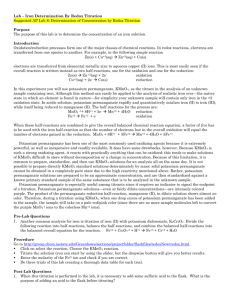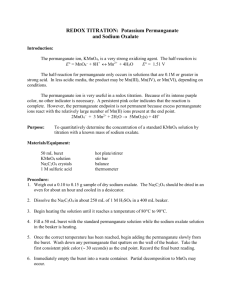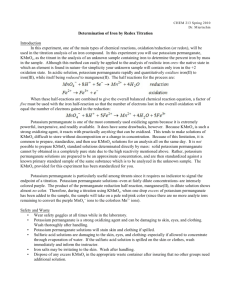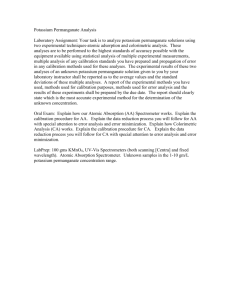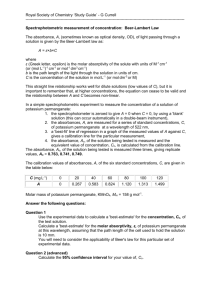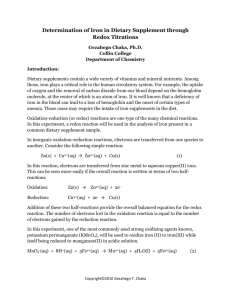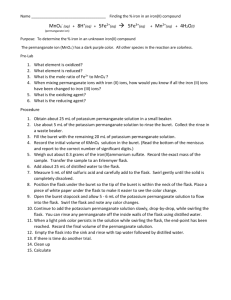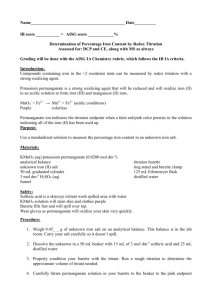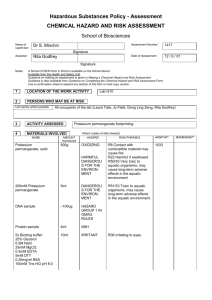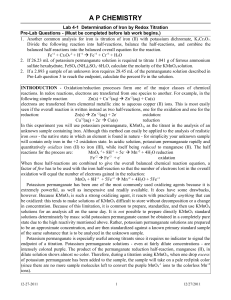A REDOX Titration - hermansenssciencespace
advertisement
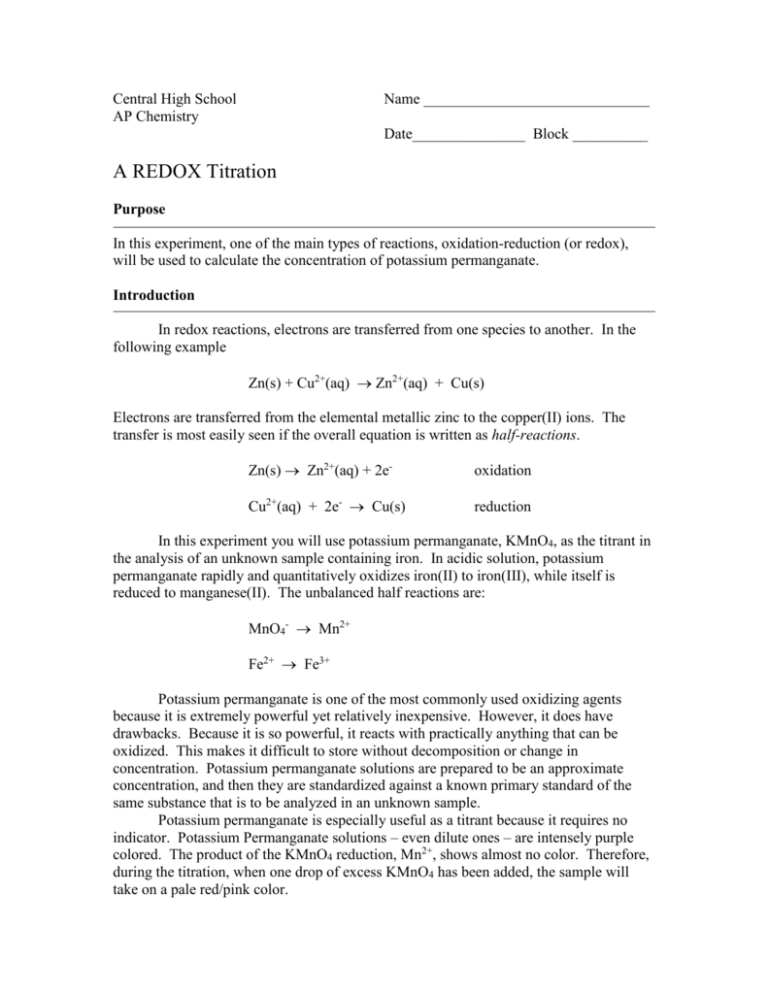
Central High School AP Chemistry Name ______________________________ Date_______________ Block __________ A REDOX Titration Purpose In this experiment, one of the main types of reactions, oxidation-reduction (or redox), will be used to calculate the concentration of potassium permanganate. Introduction In redox reactions, electrons are transferred from one species to another. In the following example Zn(s) + Cu2+(aq) Zn2+(aq) + Cu(s) Electrons are transferred from the elemental metallic zinc to the copper(II) ions. The transfer is most easily seen if the overall equation is written as half-reactions. Zn(s) Zn2+(aq) + 2e- oxidation Cu2+(aq) + 2e- Cu(s) reduction In this experiment you will use potassium permanganate, KMnO4, as the titrant in the analysis of an unknown sample containing iron. In acidic solution, potassium permanganate rapidly and quantitatively oxidizes iron(II) to iron(III), while itself is reduced to manganese(II). The unbalanced half reactions are: MnO4- Mn2+ Fe2+ Fe3+ Potassium permanganate is one of the most commonly used oxidizing agents because it is extremely powerful yet relatively inexpensive. However, it does have drawbacks. Because it is so powerful, it reacts with practically anything that can be oxidized. This makes it difficult to store without decomposition or change in concentration. Potassium permanganate solutions are prepared to be an approximate concentration, and then they are standardized against a known primary standard of the same substance that is to be analyzed in an unknown sample. Potassium permanganate is especially useful as a titrant because it requires no indicator. Potassium Permanganate solutions – even dilute ones – are intensely purple colored. The product of the KMnO4 reduction, Mn2+, shows almost no color. Therefore, during the titration, when one drop of excess KMnO4 has been added, the sample will take on a pale red/pink color. Procedure_______________________________________________________________ Standardization of the KMnO4 Solution The potassium permanganate solution is approximately 0.01 molar. Since it is such a powerful oxidizing agent, you will need to standardize the solution to find its exact molarity. 1. Obtain about 100 mL of potassium permanganate solution in a clean dry beaker. 2. Clean out a buret by rinsing it with several portions of tap water, followed by several small rinsings with distilled water. Finally rinse the buret with several 4-6 mL portions of potassium permanganate solution. Tilt and rotate the buret so the inside walls are completely rinsed with the permanganate and allow the solution to run out of the tip. 3. Fill the buret to slightly above the zero mark with KMnO4. Allow a few milliliters to run out of the tip of the buret to remove any air bubbles. Record the initial volume. 4. Pipet 10.00 mL of .100 M Iron Ammonium Sulfate Fe(NH4)2(SO4)2*6H2O (IAS) into a Erlyenmeyer flask. 5. Place the sample under the tip of the buret and begin addition of KMnO4 solution a few milliliters at a time, swirling the flask after each addition. As the permanganate is added, red streaks may be visible in the sample until the KMnO4 has a chance to mix and react with the iron(II). 6. When the red streaks become more persistent, add the KMnO4 1 drop at a time. The end point is the first appearance of a permanent pale pink color. Record the final volume of the KMnO4 solution. 7. Pour the sample into the waste beaker. Clean your flask. 8. Titrate two more samples of IAS in the same manner. Calculations_____________________________________________________________ 1. Balance the redox reaction for the titration of permanganate with iron (II) in acidic solution. 2. From the volume of each IAS sample, calculate the moles of Fe+2. 3. Calculate the moles of MnO4- . 4. Calculate the average molarity of your permanganate sample. 5. Calculate the moles of electrons iron lost in the reaction. 6. Determine the number of moles of electrons permanganate gained in the reaction. 7. Divide the moles of electrons gained by the moles of permanganate. 8. Determine how many milligrams of Iron were present in your sample. Questions_______________________________________________________________ 1. Why is no indicator needed in this titration? 2. What is the significance of the answer in Calculation #7? Data__________________________________________________________________ Standardization of KMnO4 Solution. Data Sample1 Volume of (IAS) mL Initial KMnO4 Volume (mL) Final KMnO4 Volume (mL) Sample 2 Sample 3 Analysis of an Iron Tablet_________________________________________________ Procedure 1. 2. 3. 4. 5. 6. Obtain about 25 mL of 1.5 M Sulfuric Acid in a graduated cylinder. Grind up your iron tablet in a beaker with the end of a test tube. Add the sulfuric acid the iron tablet and stir to dissolve. Filter the contents into a clean Erlenmeyer flask. Titrate with standardized potassium permanganate. Look up the reported mass of Iron in the tablet on the bottle. Record in you data table. Calculations_____________________________________________________________ 1. Determine experimental mass (in milligrams) of iron(II) present in your tablet. 2. Calculate the percent error. Data___________________________________________________________________ Sample1 Initial KMnO4 Volume (mL) Final KMnO4 Volume (mL) Theoretical Mass (from bottle) (g) References http://www.csvrgs.k12.va.us/Courses/EnvironmentalChem/lab/Redox_LAB.htm http://www.sas.upenn.edu/~tloschia/AP/labs/iron-redox.htm
